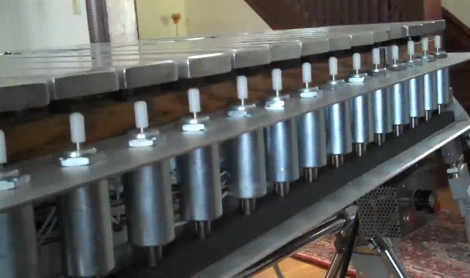
What sounds like a sex-toy is actually the reason these musicians haven’t been practicing. Marv is the MIDI actuated robotic vibraphone built by [Tim O’Keefe], [Michael McIntyre], and [Brock Roland]. Every key has a solenoid positioned below it. The beauty here is that other than four small holes used for mounting, the vibraphone hasn’t been altered at all. The solenoids are positioned on the outside edges of the instrument but there’s also a hidden secret. A set of dampers have been installed between the two ranks of keys. These are used to stop dampen ringing keys after the note should have stopped.
These guys have exhibited some beautiful craftsmanship. Check out the videos after the break and if you have the chance, see Marv in person at BarBot 2010. If you do attend that robot extravaganza don’t miss your chance to enjoy a breast-pump actuated cocktail.
[youtube=http://www.youtube.com/watch?v=yshWmtZYbtA]
Flight of the Bumblebee performance
[youtube=http://www.youtube.com/watch?v=nt_W7A_MQGQ]
Damper testing
[via Laughing Squid]
















this is how(modern)player pianos work too
Why do all EE lab rooms look the same? I could swear these guys are in Everitt lab on the UIUC engineering campus.
beautifully built. I don’t even want to think about how much it must have cost.
is it supposed to sound like that? I expected more of a rich tone
They should make a kit
>is it supposed to sound like that? I expected more of a rich tone
Perhaps because they are striking the bars at the edge rather than in the middle?
They should swap the position of the dampeners and strikers. The position of the dampeners doesn’t matter as much as the strikers. Would be a nicer sound.
@Anthony
As shown in the damper test video, the dampers seem to make more noise when switching than the solenoids.
If that is the case, I imagine that swapping their positions would cause some undesirable clicking during use.
Ruth Underwood is bound to be pissed off by this!
it doesn’t sound quite right because of a number of things, its probably being played via midi, so timing will be rigid, same goes for damping and striking at the edge too.
I wonder if this kit wouldn’t sound better connected to a xylophone rather than a vibraphone…
Oh, wow!
Just wanted to point out that there is normally a damper bar between the two sets of keys that is operated by a foot pedal under normal operation. They just replaced that with a system of individual dampers since a human can also use the mallets to soften dampen keys as needed.
As for the sound, I’m thinking the reason it sounds harsher than normal is because, at least it looks like, the keys are being hit by solid plastic/rubber. Vibraphone mallets are generally have a rubber core, but are then wrapped in several layers of yarn to soften the blow, resulting in a less harsh sound. I know from experience that if you strike a vibraphone key with just a rubber mallet, it produces a sound closer to that in the video.
I love vibes ;-)
Cool project, but I agree it does sound a bit rigid.
He mentions inspiration from Godfried-Willem Raes… that guy is freaky crazy ;-)
http://www.logosfoundation.org/instrum-god.html
Its an impressive system but i would have prefered to see hammers sitting over the keys instead, i imagine it would have given a much truer sound. Unless they were going for a system that could still be played normally or they were more concerned about the aesthetics
@MG: You’re exactly right, it’s the Delrin tips that account for the overly bright tone. I’m working on some different materials for the tips to soften it up. The sound doesn’t vary much whether it’s struck at the end or the center (some, but not too much). Humans will always have better tone than Marv, though, it’s true.
@Apothus: Simultaneous human playing was a -key- design factor. Hopefully the improved tips will bring us closer to a round sound. (Check the YouTube “Song for my Father” video to see it duet with a human)
Thanks everyone for your comments and interest! Next up: Marv with a full robotic backup band…
It seems that the dampers don’t work right, there isn’t enough clearance. They need a half inch travel. This explains the plinky tone. Get that awful foam rubber off and use wool felt hammer rail felt from a piano rebuilder. Where is the vib?
The elegant way is to do what a piano does or Deagan chimes in organ use. One actuator overshot to strike and holding damper off at the same time. Thus striker has two levels of power, strike and hold. I install players in existing pianos.
Gary Burton and John Cougar from Seymour Indiana.